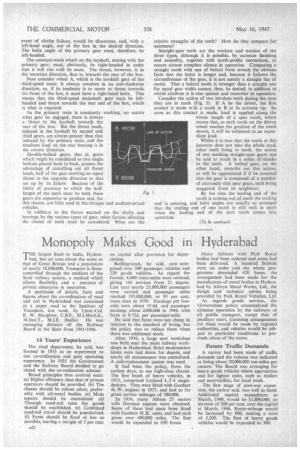Monopoly Makes Good in Hyderabad
Page 52

If you've noticed an error in this article please click here to report it so we can fix it.
THE largest State in India, Hyderabad, has an area about the same as that of Great Britain and a population of nearly 18,000,000. Transport is Statecontrolled through the medium of the State railway system, a method which allows flexibility and a measure of private enterprise in operation.
A multitude of details, facts and figures about the co-ordination of road and rail in Hyderabad was contained in a paper read to the Institute of Transport, last week, by Lieut.-Col. E. W. Slaughter, C.13.E., M.I.Mech.E., M.LE. (India). He was managing director of the Railway Board in the State from 1941-1946.
14 Years' Experience
The road department, he said, was formed in 1933 as an experiment to test co-ordination and gain operating experience. In 1935 the Government and the Railway Board decided to go ahead with the co-ordination scheme.
Broad principles thus evolved were: (a) Higher efficiency than that of private operators should be provided. (b) The chassis should he robust oilers, preferably with all-metal bodies, (c) Main repairs should be centralized. (d) Through road-rail rates for goods should be established. (e) Combined road-rail travel should be popularized. (1) Fares should be fixed as low as possible, leaving a margin of 5 per cent. on capital after provision for depreciation.
Rolling-stock, he said, now comprised over 300 passenger vehicles and 220 goods vehicles. As regard the former, 4,400 route-miles were covered, giving 144 services from 21 depots. Last year nearly 21,000,000 passengers were carried and passenger • miles reached 195,000,000, or 95 per cent. more than in 1939. Earnings per busmile were about 15.6d. and passenger earnings about £600,000 in 1946, with fares at 0.72d. per passenger-mile.
He said that fares were not cheap in relation to the standard of living, but the policy was to reduce them when there was additional stock.
After 1936, a large new workshop was built near the main railway workshops in Hyderabad. Strict maintenance limits were laid down for depots, and nearly all maintenance was centralized. A unit-replacement system was used.
It had been the policy, from the earliest days, to use high-class chassis. The first batch of heavy vehicles, in 1933, comprised Leyland L.T.4 singledeckers. They were fitted with Gardner 4L.W. engines in 1937, and had so far given service mileages of 380,000.
In 1934, many Albion 27 seaters with Dorman engines were obtained. Some of these had since been fitted with Gardner 4L.K. units, and had each given over 400,000 miles. The fleet would be expanded to 650 buses. Many Albions with Park Royal bodies had been ordered and some had been delivered. A hundred Bristols were on order and the whole programme demanded 420 buses. An arrangement had been made for the manufacture of metal bodies in Hyderabad by Allwyn Metal Works, Ltd., the design and technical advice being provided by Park Royal Vehicles, Ltd.
As regards goods services, the Government policy contemplated the ultimate operation by the railways of all public transport, except that of ancillary users. Licensing arrangements for these would be made by regional authorities, and vehicles would be subject to particular conditions to preclude abuse of the terms.
• Future Traffic Demands A survey had been made of traffic demands and the volume was indicated as being about 20,000,000 ton-miles per• annum. The Board was arranging for heavy goods vehicles where appropriate and for lighter units, such as trailers and semi-trailers, for local work.
The first stage of post-war expansion, the author said, was well in hand. Additional capital expenditure to March, 1948, would be £1,800,000, an increase of 200 per cent, over the capital at March, 1946. Route-mileage would be increased by 800, making a total of 5,200. The fleet of heavy goods vehicles would be expanded to 300.












































































